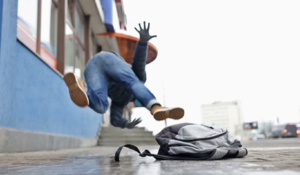
Prevention
- Wear proper foot gear
- Take smaller steps when walking
- Walk slowly and never run on icy ground
- Keep both hands free for balance rather than in your pockets
- Use handrails from start to finish
- Avoid carrying loads
- Keep your eyes on where you are going
- Test potentially slick areas by tapping your foot on them
- Step – don’t jump – from vehicles or equipment
- Keep walkways clear of debris, water, ice, and slippery materials
When given no choice but to walk on ice, consider the following:
- Take short steps or shuffle for stability
- Bend slightly, walk flat-footed with your center of gravity directly over your feet as much as possible
- Be prepared to fall
- If you fall, fall with sequential contacts at your thigh, hip and shoulder to avoid using your arms to protect against breakage
- Roll with the fall. Try to twist and roll backwards, rather than falling forward
- Relax as much as possible when you begin to fall
- Bend your back and head forward so you won’t slam your head on the pavement as your feet shoot out from under you
- Toss the load you are carrying. Protect yourself instead of the objects being carried
 Safe winter walking
Safe winter walking
- Plan ahead; give yourself sufficient time and plan your route
- Wear shoes that provide traction on snow or ice: rubber and neoprene composite. Avoid plastic or leather soles
- Walk in designated walkways as much as possible
- If a walkway is completely covered with ice, try to travel along its grassy edge for traction
When entering buildings, remove snow and water from footwear to prevent wet and slippery conditions indoors.
